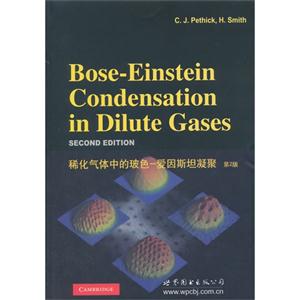稀化气体中的玻色-爱因斯坦凝聚-第2版
本书特色
[
《稀化气体中的玻色:爱因斯坦凝聚(第2版)》是一部关于稀化气体中玻色—爱因斯坦凝聚的专著。早在1925年爱因斯坦便预言,气态粒子在低温下会在各方面处于同样的量子状态。《稀化气体中的玻色:爱因斯坦凝聚(第2版)》重点论述其基础物理原理。全书共14章,每章末附有问题和参考文献,书末附有基本常数和转换因数的附录。《稀化气体中的玻色:爱因斯坦凝聚(第2版)》适用于高校物理系及相关专业的教师、研究生和从事新物态及相关研究的科研工作者。
]
目录
preface 1 introduction 1.1 bose—einstein condensation in atomic clouds 1.2 superfluid 4he 1.3 other condensates 1.4 overview problems references 2 the non—interacting bose gas 2.1 the bose distribution 2.1.1 density of states 2.2 transition temperature and condensate fraction 2.2.1 condensate fraction 2.3 density profile and velocity distribution 2.3.1 the semi—classical distribution 2.4 thermodynamic quantities 2.4.1 condensed phase 2.4.2 normal phase 2.4.3 specific heat close to tc 2.5 effect of finite particle number problems references 3 atomic properties 3.1 atomic structure 3.2 the zeeman effect 3.3 response to an electric field 3.4 energy scales problems references 4 trapping and cooling of atoms 4.1 magnetic traps 4.1.1 the quadrupole trap 4.1.2 the top trap 4.1.3 magnetic bottles and the ioffe—pritchard trap 4.1.4 microtraps 4.2 influence of laser light on an atom 4.2.1 forces on an atom in a laser field 4.2.2 optical traps 4.3 laser cooling: the doppler process 4.4 the magneto—optical trap 4.5 sisyphus cooling 4.6 evaporative cooling 4.7 spin—polarized hydrogen problems references 5 interactions between atoms 5.1 interatomic potentials and the van der waals interaction 5.2 basic scattering theory 5.2.1 effective interactions and the scattering length 5.3 scattering length for a model potential 5.4 scattering between different internal states 5.4.1 inelastic processes 5.4.2 elastic scattering and feshbach resonances 5.5 determination of scattering lengths 5.5.1 scattering lengths for alkali atoms and hydrogen problems references 6 theory of the condensed state 6.1 the gross—pitaevskii equation 6.2 the ground state for trapped bosons 6.2.1 a variational calculation 6.2.2 the thomas—fermi approximation 6.3 surface structure of clouds 6.4 healing of the condensate wave function 6.5 condensates with dipolar interactions problems references 7 dynamics of the condensate 7.1 general formulation 7.1.1 the hydrodynamic equations 7.2 elementary excitations 7.3 collective modes in traps 7.3.1 traps with spherical symmetry 7.3.2 anisotropic traps 7.3.3 collective coordinates and the variational method 7.4 surface modes 7.5 free expansion of the condensate 7.6 solitons 7.6.1 dark solitons 7.6.2 bright solitons problems references 8 microscopic theory of the bose gas 8.1 the uniform bose gas 8.1.1 the bogoliubov transformation 8.1.2 elementary excitations 8.1.3 depletion of the condensate 8.1.4 ground—state energy 8.1.5 states with definite particle number 8.2 excitations in a trapped gas 8.3 non—zero temperature 8.3.1 the hartree—fock approximation 8.3.2 the popov approximation 8.3.3 excitations in non—uniform gases 8.3.4 the semi—classical approximation problems references 9 rotating condensates 9.1 potential flow and quantized circulation 9.2 structure of a single vortex 9.2.1 a vortex in a uniform medium 9.2.2 vortices with multiple quanta of circulation 9.2.3 a vortex in a trapped cloud 9.2.4 an off—axis vortex 9.3 equilibrium of rotating condensates 9.3.1 traps with an axis of symmetry 9.3.2 rotating traps 9.3.3 vortex arrays 9.4 experiments on vortices 9.5 rapidly rotating condensates 9.6 collective modes in a vortex lattice problems references 10 superfluidity 10.1 the landau criterion 10.2 the two—component picture 10.2.1 momentum carried by excitations 10.2.2 normal fluid density 10.3 dynamical processes 10.4 first and second sound 10.5 interactions between excitations 10.5.1 landau damping problems references 11 trapped clouds at non—zero temperature 11.1 equilibrium properties 11.1.1 energy scales 11.1.2 transition temperature 11.1.3 thermodynamic properties 11.2 collective modes 11.2.1 hydrodynamic modes above tc 11.3 collisional relaxation above tc 11.3.1 relaxation of temperature anisotropies 11.3.2 damping of oscillations problems references 12 mixtures and spinor condensates 12.1 mixtures 12.1.1 equilibrium properties 12.1.2 collective modes 12.2 spinor condensates 12.2.1 mean—field description 12.2.2 beyond the mean—field approximation problems references 13 interference and correlations 13.1 tunnelling between two wells 13.1.1 quantum fluctuations 13.1.2 squeezed states 13.2 interference of two condensates 13.2.1 phase—locked sources 13.2.2 clouds with definite particle number 13.3 density correlations in bose gases 13.3.1 collisional shifts of spectral lines 13.4 coherent matter wave optics 13.5 criteria for bose—einstein condensation 13.5.1 the density matrix 13.5.2 fragmented condensates problems references 14 optical lattices 14.1 generation of optical lattices 14.1.1 one—dimensional lattices 14.1.2 higher—dimensional lattices 14.1.3 energy scales 14.2 energy bands 14.2.1 band structure for a single particle 14.2.2 band structure for interacting particles 14.2.3 tight—binding model 14.3 stability 14.3.1 hydrodynamic analysis 14.4 intrinsic non—linear effects 14.4.1 loops 14.4.2 spatial period doubling 14.5 from superfluid to insulator 14.5.1 mean—field approximation 14.5.2 effect of trapping potential 14.5.3 experimental detection of coherence problems references 15 lower dimensions 15.1 non—interacting gases 15.2 phase fluctuations 15.2.1 vortices and the berezinskii—kosterlitz—thouless transition 15.3 microscopic theory of phase fluctuations 15.3.1 uniform systems 15.3.2 anisotropic traps 15.4 the one—dimensional bose gas 15.4.1 the strong—coupling limit 15.4.2 arbitrary coupling 15.4.3 correlation functions problems references 16 fermions 16.1 equilibrium properties 16.2 effects of interactions 16.3 superfluidity 16.3.1 transition temperature 16.3.2 induced interactions 16.3.3 the condensed phase 16.4 pairing with unequal populations 16.5 boson—fermion mixtures 16.5.1 induced interactions in mixtures problems references 17 from atoms to molecules 17.1 bose—einstein condensation of molecules 17.2 diatomic molecules 17.2.1 binding energy and the atom—atom scattering length 17.2.2 a simple two—channel model 17.2.3 atom—atom scattering 17.3 crossover: from bcs to bec 17.3.1 wide and narrow feshbach resonances 17.3.2 the bcs wave function 17.3.3 crossover at zero temperature 17.3.4 condensate fraction and pair wave function 17.4 crossover at non—zero temperature 17.4.1 thermal molecules 17.4.2 pair fluctuations and thermal molecules 17.4.3 density of atoms 17.4.4 transition temperature 17.5 a universal limit 17.6 experiments in the crossover region 17.6.1 collective modes 17.6.2 vortices problems references appendix.fundamental constants and conversion factors inder
封面

书名:稀化气体中的玻色-爱因斯坦凝聚-第2版
作者:佩西克
页数:569
定价:¥129.0
出版社:世界图书出版公司
出版日期:2014-09-01
ISBN:9787510078576
PDF电子书大小:156MB 高清扫描完整版
